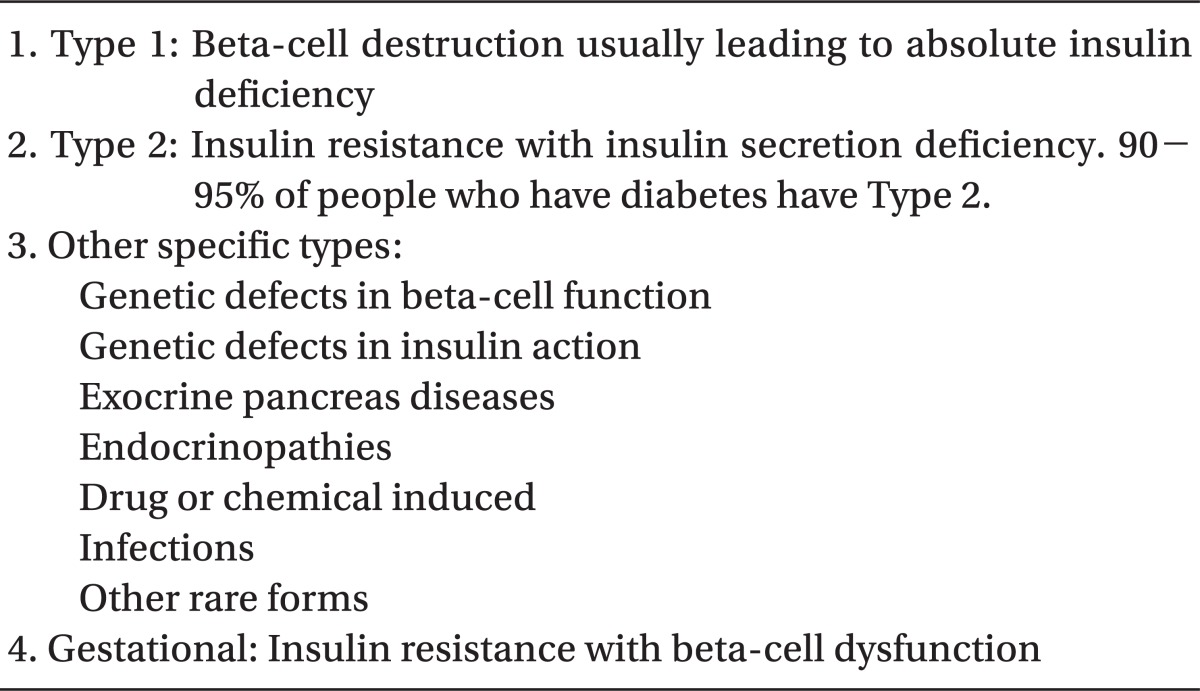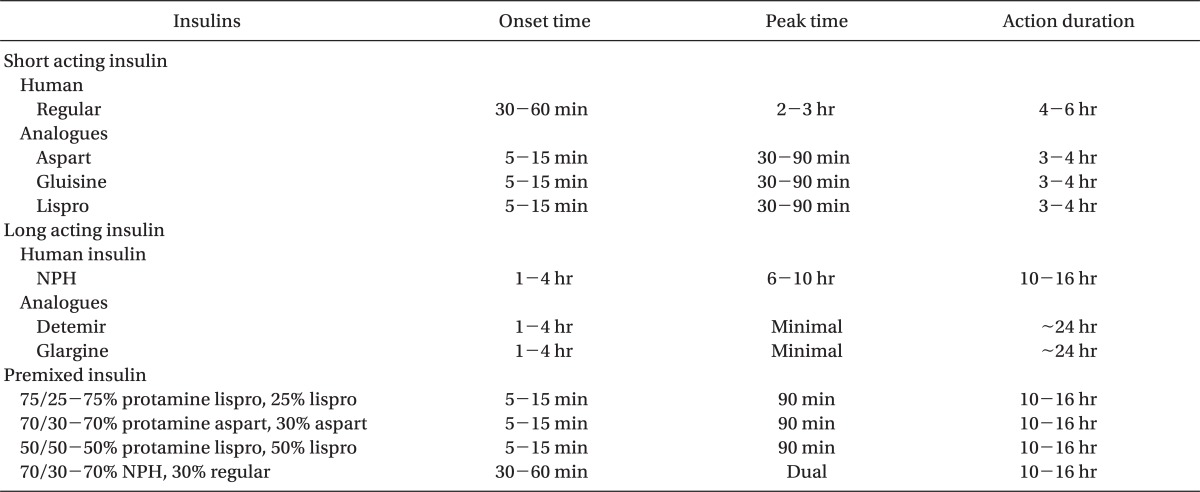1. The global challenge of diabetes. Lancet. 2008; 371:1723. PMID:
18502275.
2. Task Force Team for Basic Statistical Study of Korean Diabetes Mellitus. Report of Task Force Team for Basic Statistical Study of Korean Diabetes Mellitus: diabetes in Korea 2007. 2007. Seoul: Goldfishery;p. 14–21.
3. Kim DJ. The Epidemiology of diabetes in Korea. Diabetes Metab J. 2011; 35:303–308. PMID:
21977448.

4. UK Prospective Diabetes Study (UKPDS) Group. Intensive blood-glucose control with sulphonylureas or insulin compared with conventional treatment and risk of complications in patients with type 2 diabetes (UKPDS 33). Lancet. 1998; 352:837–853. PMID:
9742976.
5. American Diabetes Association. Diagnosis and classification of diabetes mellitus. Diabetes Care. 2004; 27(Suppl 1):S5–S10. PMID:
14693921.
6. Report of the expert committee on the diagnosis and classification of diabetes mellitus. Diabetes Care. 1997; 20:1183–1197. PMID:
9203460.
7. UK Prospective Diabetes Study Group. Tight blood pressure control and risk of macrovascular and microvascular complications in type 2 diabetes: UKPDS 38. BMJ. 1998; 317:703–713. PMID:
9732337.
8. Hanefeld M, Temelkova-Kurktschiev T, Schaper F, Henkel E, Siegert G, Koehler C. Impaired fasting glucose is not a risk factor for atherosclerosis. Diabet Med. 1999; 16:212–218. PMID:
10227566.

9. DECODE Study Group. European Diabetes Epidemiology Group. Is the current definition for diabetes relevant to mortality risk from all causes and cardiovascular and noncardiovascular diseases? Diabetes Care. 2003; 26:688–696. PMID:
12610023.
10. Halkos ME, Lattouf OM, Puskas JD, Kilgo P, Cooper WA, Morris CD, et al. Elevated preoperative hemoglobin A1c level is associated with reduced long-term survival after coronary artery bypass surgery. Ann Thorac Surg. 2008; 86:1431–1437. PMID:
19049726.

11. Marchant MH Jr, Viens NA, Cook C, Vail TP, Bolognesi MP. The impact of glycemic control and diabetes mellitus on perioperative outcomes after total joint arthroplasty. J Bone Joint Surg Am. 2009; 91:1621–1629. PMID:
19571084.

12. Bailey CJ, Turner RC. Metformin. N Engl J Med. 1996; 334:574–579. PMID:
8569826.

13. Inzucchi SE, Bergenstal RM, Buse JB, Diamant M, Ferrannini E, Nauck M, et al. Management of hyperglycaemia in type 2 diabetes: a patient-centered approach. Position statement of the American Diabetes Association (ADA) and the European Association for the Study of Diabetes (EASD). Diabetologia. 2012; 55:1577–1596. PMID:
22526604.

14. Mahler RJ. Metformin: actions and indications for use in non-insulin-dependent diabetes mellitus. Endocr Pract. 1995; 1:418–422. PMID:
15251570.

15. Aguilar-Bryan L, Nichols CG, Wechsler SW, Clement JP 4th, Boyd AE 3rd, Gonzalez G, et al. Cloning of the beta cell high-affinity sulfonylurea receptor: a regulator of insulin secretion. Science. 1995; 268:423–426. PMID:
7716547.
16. Leibowitz G, Cerasi E. Sulphonylurea treatment of NIDDM patients with cardiovascular disease: a mixed blessing? Diabetologia. 1996; 39:503–514. PMID:
8739909.

17. Zoungas S, de Galan BE, Ninomiya T, Grobbee D, Hamet P, Heller S, et al. Combined effects of routine blood pressure lowering and intensive glucose control on macrovascular and microvascular outcomes in patients with type 2 diabetes: New results from the ADVANCE trial. Diabetes Care. 2009; 32:2068–2074. PMID:
19651921.
18. Fuhlendorff J, Rorsman P, Kofod H, Brand CL, Rolin B, MacKay P, et al. Stimulation of insulin release by repaglinide and glibenclamide involves both common and distinct processes. Diabetes. 1998; 47:345–351. PMID:
9519738.

19. Yki-Jarvinen H. Thiazolidinediones. N Engl J Med. 2004; 351:1106–1118. PMID:
15356308.

20. Kahn SE, Haffner SM, Heise MA, Herman WH, Holman RR, Jones NP, et al. Glycemic durability of rosiglitazone, metformin, or glyburide monotherapy. N Engl J Med. 2006; 355:2427–2443. PMID:
17145742.

21. Dormandy JA, Charbonnel B, Eckland DJ, Erdmann E, Massi-Benedetti M, Moules IK, et al. Secondary prevention of macrovascular events in patients with type 2 diabetes in the PROactive Study (PROspective pioglitAzone Clinical Trial In macroVascular Events): a randomised controlled trial. Lancet. 2005; 366:1279–1289. PMID:
16214598.

22. Nesto RW, Bell D, Bonow RO, Fonseca V, Grundy SM, Horton ES, et al. Thiazolidinedione use, fluid retention, and congestive heart failure: a consensus statement from the American Heart Association and American Diabetes Association. October 7, 2003. Circulation. 2003; 108:2941–2948. PMID:
14662691.
23. Chiasson JL, Josse RG, Hunt JA, Palmason C, Rodger NW, Ross SA, et al. The efficacy of acarbose in the treatment of patients with non-insulin-dependent diabetes mellitus. A multicenter controlled clinical trial. Ann Intern Med. 1994; 121:928–935. PMID:
7734015.

24. Sheehan MT. Current therapeutic options in type 2 diabetes mellitus: a practical approach. Clin Med Res. 2003; 1:189–200. PMID:
15931309.

25. Kennedy L. Incretin-based therapies for type 2 diabetes mellitus: New therapeutic mechanisms. Cleve Clin J Med. 2009; 76(Suppl 5):S2–S3. PMID:
19952299.

26. Drucker DJ. The biology of incretin hormones. Cell Metab. 2006; 3:153–165. PMID:
16517403.

27. Juhl CB, Hollingdal M, Sturis J, Jakobsen G, Agerso H, Veldhuis J, et al. Bedtime administration of NN2211, a long-acting GLP-1 derivative, substantially reduces fasting and postprandial glycemia in type 2 diabetes. Diabetes. 2002; 51:424–429. PMID:
11812750.

28. Amori RE, Lau J, Pittas AG. Efficacy and safety of incretin therapy in type 2 diabetes: systematic review and meta-analysis. JAMA. 2007; 298:194–206. PMID:
17622601.
29. Deacon CF. Dipeptidyl peptidase-4 inhibitors in the treatment of type 2 diabetes: a comparative review. Diabetes Obes Metab. 2011; 13:7–18. PMID:
21114598.

30. Pratley RE, Salsali A. Inhibition of DPP-4: a new therapeutic approach for the treatment of type 2 diabetes. Curr Med Res Opin. 2007; 23:919–931. PMID:
17407649.

31. Wright DH, Herman GA, Maes A, Liu Q, Johnson-Levonas AO, Wagner JA. Multiple doses of sitagliptin, a selective DPP-4 inhibitor, do not meaningfully alter pharmacokinetics and pharmacodynamics of warfarin. J Clin Pharmacol. 2009; 49:1157–1167. PMID:
19783710.

32. Jabbour S. Primary care physicians and insulin initiation: multiple barriers, lack of knowledge or both? Int J Clin Pract. 2008; 62:845–847. PMID:
18479275.

33. Wyne KL, Mora PF. Insulin therapy in type 2 diabetes. Endocr Res. 2007; 32:71–107. PMID:
18092196.

34. Holleman F, Hoekstra JB. Insulin lispro. N Engl J Med. 1997; 337:176–183. PMID:
9219705.

35. Holman RR, Farmer AJ, Davies MJ, Levy JC, Darbyshire JL, Keenan JF, et al. Three-year efficacy of complex insulin regimens in type 2 diabetes. N Engl J Med. 2009; 361:1736–1747. PMID:
19850703.

36. Smith U, Gale EA. Does diabetes therapy influence the risk of cancer? Diabetologia. 2009; 52:1699–1708. PMID:
19597799.

37. Robertshaw HJ, Hall GM. Diabetes mellitus: anaesthetic management. Anaesthesia. 2006; 61:1187–1190. PMID:
17090240.

38. The sixth report of the Joint National Committee on prevention, detection, evaluation, and treatment of high blood pressure. Arch Intern Med. 1997; 157:2413–2446. PMID:
9385294.
39. Frisch A, Chandra P, Smiley D, Peng L, Rizzo M, Gatcliffe C, et al. Prevalence and clinical outcome of hyperglycemia in the perioperative period in noncardiac surgery. Diabetes Care. 2010; 33:1783–1788. PMID:
20435798.

40. van den Berghe G, Wouters P, Weekers F, Verwaest C, Bruyninckx F, Schetz M, et al. Intensive insulin therapy in critically ill patients. N Engl J Med. 2001; 345:1359–1367. PMID:
11794168.

41. Finney SJ, Zekveld C, Elia A, Evans TW. Glucose control and mortality in critically ill patients. JAMA. 2003; 290:2041–2047. PMID:
14559958.

42. Hirsch IB, McGill JB, Cryer PE, White PF. Perioperative management of surgical patients with diabetes mellitus. Anesthesiology. 1991; 74:346–359. PMID:
1990909.

43. Ryan GJ, Jobe LJ, Martin R. Pramlintide in the treatment of type 1 and type 2 diabetes mellitus. Clin Ther. 2005; 27:1500–1512. PMID:
16330288.

44. Kang H, Ahn KJ, Choi JY, Park HJ, Park SJ, Lee SK. Efficacy of insulin glargine in perioperative glucose control in type 2 diabetic patients. Eur J Anaesthesiol. 2009; 26:666–670. PMID:
19367171.

45. Cure P, Pileggi A, Alejandro R. Exenatide and rare adverse events. N Engl J Med. 2008; 358:1969–1970. PMID:
18450614.





 PDF
PDF Citation
Citation Print
Print






 XML Download
XML Download